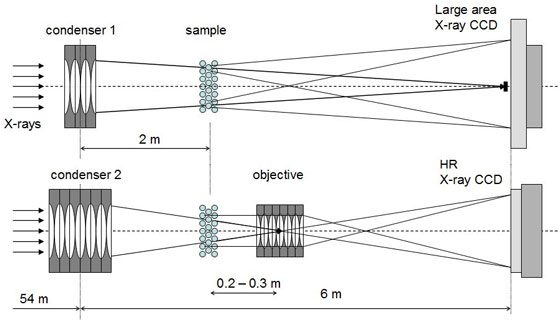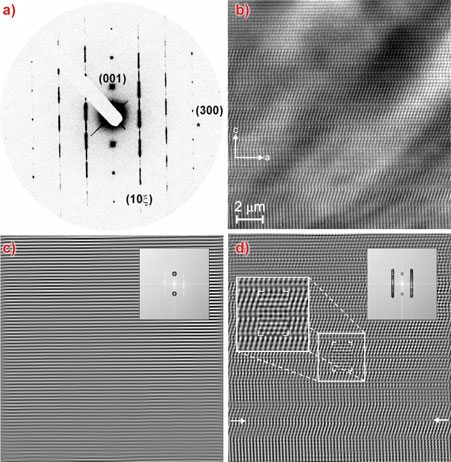- Home
- News
- Spotlight on Science
- Coherent high-resolution...
Coherent high-resolution transmission X-ray microscopy: a new tool for mesoscopic materials
26-01-2011
A new high-resolution transmission X-ray microscopy technique using parabolic compound refractive lenses facilitates the volume-specific studies of mesoscopic photonic crystals. High-resolution diffraction patterns and real-space images are retrieved simultaneously by making use of the coherent properties of synchrotron X-ray beams along with tunable refractive optics.
Share
Photonic crystals with a periodically-organised refractive index of the order of the wavelength of light have attracted much attention in the past decade for controlling and manipulating the flow of light [1]. Although the fabrication of 3D optical photonic crystals is cumbersome and complex, a number of methods have been developed. These include the microlithographic technique, self-assembly of colloidal crystals, and a replicating process based on self-assembly in which voids of colloidal crystals are infiltrated with a certain material to produce high refractive index inverse photonic crystals. Unfortunately, the incorporation of defects is still a major problem for applications, as these defects affect the optical properties. Therefore, detailed knowledge of defect structures and defect growth in photonic crystals is required. Studying the internal structure of photonic crystals is inherently difficult: the mesoscale can be probed by imaging or diffraction methods. Imaging techniques are exclusively limited to surface imaging. Diffraction methods – visible light diffraction and small-angle X-ray scattering – provide invaluable information on the volume-specific structure, but often limited to the space average.
We have developed a high-resolution transmission X-ray microscopy (HRTXM) technique, based on the use of parabolic refractive lenses [2]. The immediate benefit of a lens-based approach is the possibility to retrieve the Fraunhofer diffraction pattern and real-space images in the same experimental setup [3,4]. This approach is methodologically similar to the traditional method of studying crystalline samples with high-resolution transmission electron microscopy. In the present work, we demonstrate the applicability of the HRTXM approach to volume-specific studies of periodic mesoscopic structures, such as photonic crystals.
The HRTXM experiment was carried out at the micro-optics test bench of beamline ID06. X-rays from 10 to 20 keV were used. The setup consists of two sets of condensers – used for sample illumination in imaging mode and as Fourier transformer in diffraction mode, the objective lens and two (large area and high resolution) CCD detectors (Figure 1). The tunable objective lens provides a magnification between 10 and 25. At maximum magnification, a resolution of ~100 nm was achieved. For this benchmark study, a ~70 µm thick single domain grain of Australian gem opal was used as a prototypical photonic crystal.
 |
|
Figure 1. Conceptual layout of the X-ray microscope. Diffraction and imaging modes (upper and lower panels, respectively). |
Figure 2 shows a selected area diffraction pattern taken with the X-ray beam parallel to the <1-20> zone and its corresponding enlarged X-ray image. Reflections not satisfying the condition H = 3n transform from a well-defined round shape to modulated diffuse rods (see Figure 2a) being a signature of structural imperfections. The behaviour observed for opal is well known for a close-packed structure with stacking faults, but the surprising feature is the absence of a six-fold axis which must exist for the so-called “growth faults”. The apparent reduction of symmetry of Australian opals to a three-fold symmetry is an indication of unequal probabilities to meet A/B and B/A stacking in the structure. A stripe-like contrast variation with the stripes perpendicular to the c axis is due to a change of the packing sequence (Figure 2b). The orientation of the stripes coincides with striations observable with visible light. Figure 2d shows a filtered HRTXM image superposed with simulated patterns of a face-centered cubic (fcc) structure fragment containing a single stacking fault (…ABCABCBCABCABC… sequence), with satisfactory agreement. The most widespread packing mode is obviously f.c.c., but it is not absolutely dominating. A variety of longer-period stacking sequences can be identified, but being non-repetitive, they cannot be treated as separate “polytypes” of “phases”. The question remains as to why the A/B and B/A stacking probabilities are different in very soft hydrothermal conditions of opal sedimentation.
Recently, HRTXM was applied to structural studies of inverted photonic crystals using high energy X-rays (up to 50 keV) at beamlines ID11 and ID15, demonstrating a resolution in the order of 100 nm. Short acquisition times with modern area detectors allow the method to be extended to time-resolved studies and combined 3-D real/reciprocal space mapping. The HRTXM method can easily be implemented on existing beamlines. Characterisation of the real crystal structure during photonic crystal growth is an example of a practical application of this new technique.
References
[1] K.A. Arpin, A. Mihi, H.T. Johnson, A.J. Baca, J.A. Rogers, J.A. Lewis, P.V. Braun, Adv. Mater. 22, 1084–1101 (2010).
[2] A. Snigirev, V. Kohn, I. Snigireva, B. Lengeler, Nature 384, 49-51 (1996).
[3] V. Kohn, I. Snigireva, A. Snigirev, Opt. Comm. 216, 247-260 (2003).
[4] M. Drakopoulos, A. Snigirev, I. Snigireva, J. Schilling, Appl. Phys. Lett. 86, 014102 (2005).
Principal publication and authors
A. Bosak (a), I. Snigireva (a), K. Napolskii (b), A. Snigirev (a), High Resolution Transmission X-ray Microscopy: A New Tool for Mesoscopic Materials, Adv. Mater. 22, 3256-3259 (2010).
(a) ESRF
(b) Moscow State University (Russia)




